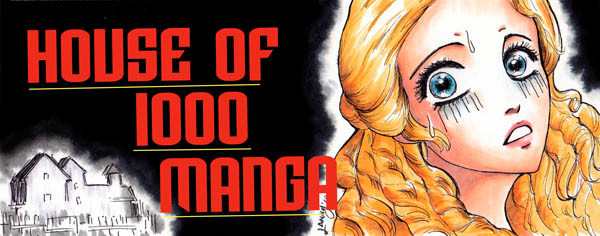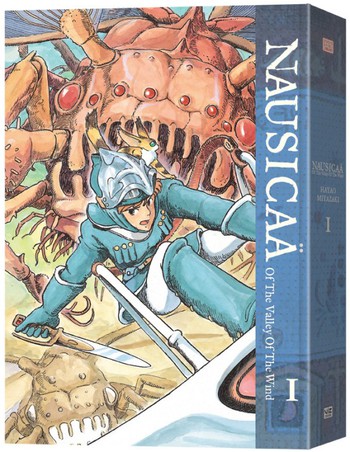House of 1000 Manga Finale: Part I
by Shaenon Garrity,
Shaenon's Ten Favorite 'House' Manga

It falls upon my bowed shoulders to announce the news: House of 1,000 Manga is ending. After five years of weekly columns, the time has come to move on. Among other things, we're kind of running out of manga. We have a lot of manga-related articles planned for the future, and I'll continue writing for Anime News Network, but this column is retiring after years of service.
At times like these I grow nostalgic, looking back on the golden past like a character in a sentimental high-school manga. (Wait, Here Is Greenwood! We never did Here Is Greenwood!) Thanks to this column, Jason Thompson and I have been able to read and share a lot of wonderful manga. Also some real stinkers, but let's remember the good times. Here are my ten favorite manga covered in House of 1,000 Manga during its storied run. I freely admit that if I wrote this tomorrow I'd probably pick ten completely different titles. There's just too much good manga.
1. Even a Monkey Can Draw Manga
After a few hundred volumes of earnest, upbeat shonen and Shōjo Manga, it's a treat to read a totally jaded manga where the characters (who are also the authors) say things like, “You don't need any extra touches for manga!! The most suitable style for manga is generic and cheerful!!” and “I know of an incredibly successful manga artist who knows how to draw nothing but closeups of large breasts!!” Even a Monkey teaches aspiring manga artists that coming up with a cool pen name is more important than writing a coherent plot, that you don't need facial expressions if you have giant sweat drops and vein lines, that coming up with a hit series is just a matter of figuring out the demographic you want to pander to, and that having artistic goals is “the spiritual cancer of adolescence.”
This manga is so wickedly hilarious, I can't believe the English translation is limited to one out-of-print volume from Viz. It's a bracing palate cleanser between rounds of normal manga. We need Monkey Manga now more than ever.
2. Nausicaä of the Valley of the Wind
Nausicaä is so good it seems unfair to put it on a list with other, mortal manga, making them look bad by comparison. At the same time, with its dense, Moebius-inspired art, it hardly looks like a manga at all. There's nothing else remotely like it. The ideal way to experience Nausicaä is to watch the Studio Ghibli movie and then tackle the manga, which follows the movie's plot for roughly its first half before delving into deeper and darker territory. But when I was a young nerd the movie was officially unavailable in English, so I read the manga first and then watched the movie, entirely untranslated, with a bunch of other Viz employees. That was when Viz had a great little screening room that people, like for example Jason, occasionally slept in overnight. Good times. And yes, I'm an old nerd.
Anyway, if you want to call yourself otaku, you have to read Nausicaä. It's the kind of manga that changes people's lives, albeit sometimes in a bad way like when the Aum Shinrikyo cult latched onto it, or when moe was invented by nerds arguing over whether Nausicaä wears pants. But usually it changes lives in a good way.
3. Club 9
Club 9 was the subject of my first House column, back when I was a mere guest writer. Of the two manga by Makoto Kobayashi published in English, I think it has a slight edge on What's Michael?, although both are fantastic. Kobayashi's art, with his rubbery faces and slapstick gags reminiscent of Western animated cartoons, bursts with personality, and his sense of humor is a perfect mix of naughty and nice. Club 9 features one of the gosh-darn cutest protagonists in manga, the cheerful, corn-fed farmgirl turned club hostess Haruo. The feather-light plot is little more than an excuse for Kobayashi to write funny scenes and draw good-looking gals in affectionate detail. It's the kind of manga you read less to find out what happens next and more to drop in on the characters and hang out with them.
Dark Horse did its usual high-quality job with the translation, provided you don't mind rural Japanese dialects being localized as “Hee-Haw” American country twang. (P.S. I love it.) It's a shame they only ever collected three of the five volumes.
4. Oishinbo
Jason and I are both huge fans of food manga, being human, but I think Jason leans a bit more toward shonen-strong cooking competition manga like Iron Wok Jan! and Yakitate!! Japan, while I love vaguely educational foodie factoid manga. Oishinbo is the king of that particular sub-sub-genre. I dig the old-school cartoony 1980s art, found in a lot of “salaryman manga,” where the characters' faces are barely more than doodles but the food is drawn in pornographic detail. The seven best-of collections from Viz, organized by theme (Sake, Pub Food, The Joy of Rice) rather than chronological order, are a perfect low-commitment entry point to a series that's over 100 volumes long and counting.
Comparing Oishinbo to its closest modern-day counterpart, the wine-specific Drops of God, you can see how food manga has changed over the decades. The comic-strip protagonists are now handsome bishonen rendered in fine-lined detail, and the plots have more soap opera and sex appeal. But the central elements are remarkably similar: the high melodrama, the intense competitions, the detailed research and food tips, and, above all, the passion for good culinary craftsmanship. There's no reason to mess with a perfect recipe.
5. Basara
Full disclosure: I worked on Basara as an editor for Viz back in the day. I fell in love with it then, and it's still one of my all-time favorite Shōjo Manga. In its rough outline, it's familiar YA fantasy material: in a postapocalyptic world, a girl disguises herself as a boy to fight for freedom for her people, while inadvertently falling in love with the handsome son of the evil king she's out to defeat. But it transcends formula, largely thanks to the intricacy and density of Yumi Tamura's plotting. There are literally hundreds of characters, but every plot thread is followed through to the end, and the main characters' arcs build and crash spectacularly. Very few long-running manga feel like they were plotted out from beginning to end, but this one does.
The art is utterly '90s, all big fluffy hair and giant sparkly bug eyes, but it's gorgeous, drawn with the same intelligence, imagination, and care with which the story is written. I really can't recommend it enough to fantasy fans. The badass feminism just sweetens the pot.
6. Black Jack
You know the best part of the chapter in Black Jack where he operates on his own intestine in the Australian outback, without anesthetic, while surrounded by ravenous dingos? He starts by saying, “This isn't the first time I've done this.” Osamu Tezuka, you are forever the god.
7. Moon Child
Every old Shōjo Manga published by CMX, DC's now-defunct manga line, is a mind-blowing must-read. If you haven't read Swan and From Eroica with Love, two radically different but equally brilliant 1970s classics, track down tragically out-of-print copies and have a time. But don't forget the 1980s fantasy Moon Child, which may very well be the weirdest manga ever published—and, yes, I know the competition is intense. It's beautiful, moody, absorbing, and utterly bizarre.
I was very upset that Jason got to this one before I did, because I was raring to write a column on it. You win this round, Jason. But when the next science-fiction/fantasy saga about a space fish descended from the Little Mermaid who takes the form of a young boy who transforms in the light of the full moon into a beautiful woman named Benjamin and falls in love with a failed Broadway hoofer comes down the pike, I'll be there. Just you wait.
8. The Manga of Shigeru Mizuki
Jason covered Mizuki's manga as a whole, but I've been tempted to go back and devote a column to just one of them. Mizuki is one of the biggest and most beloved manga-ka in Japan—his kiddie-horror hero Kitaro is as ubiquitous as Mickey Mouse and Doraemon—but only recently has Drawn and Quarterly brightened the Western world by bestowing upon us lovely translated editions of the yokai master's works.
The kids' series Gegege no Kitarō is Mizuki's career-making hit, and it's huge fun, a somewhat goofier but still creepy companion piece to Kazuo Umezo manga like Cat Eyed Boy. But I'm even more in love with his autobiographical and historical manga. The bittersweet NonNonBâ recreates Mizuki's childhood with an old woman who taught him the secrets of the spirit world; Onward Toward Our Noble Deaths details the horrors and absurdities Mizuki experienced in war; and the masterwork Showa is a history of WWII Japan filtered through the author's personal recollections. Mizuki makes a great manga character: idealistic but cynical, attuned to nature and the spirit world, alternately amused and saddened by human life, he has a voice unique to manga. The writer he most reminds me of is Kurt Vonnegut.
Plus he draws all his manga with one arm, so respect.
9. Nijigahara Holograph
In 2012, when I wrote a House column about Inio Asano, I lamented that Viz had suspended its project of publishing the up-and-coming manga-ka's work to focus on its SigIkki line, leaving the mind-bending, time-traveling, reality-warping manga Nijigahara Holograph untranslated. Since then, Fantagraphics has put out a gorgeous hardcover edition of Nijigahara Holograph that's everything I could possibly wish for. Jason covered it for House before I got to it, leaving me to curse his name Yet Again.
It's a strange, sad, disturbing and beautiful manga about a group of classmates who witness something terrible in elementary school and grow up warped by it in various ways. There are other dark secrets in their lives, as well as ghosts, supernatural butterflies, a time loop, and some kind of apocalypse slowly descending on the world. Or maybe not. I still haven't figured out Nijigahara Holograph, but that's what I like about it. That and the gorgeous artwork, which is completely unfair coming from an artist this young.
10. Thermae Romae
Writing this column has introduced me to a lot of great manga I hadn't gotten around to reading before. It's hard to single out a favorite discovery, but Thermae Romae is way up there. Going in, I had high expectations, which were surpassed. The premise—time-traveling Roman/Japanese bathhouse adventures—is so outlandish it almost has to be entertaining whether or not it's handled well. But Mari Yamazaki goes above and beyond, researching the hell out of her material and milking it for ingenious ideas. The plot and characters are as much fun as the historical details. Above all, I didn't expect it to be so funny. It's a great manga by any standard, but even more than that, it's a fun read. And isn't that why we're all here?
discuss this in the forum (42 posts) |